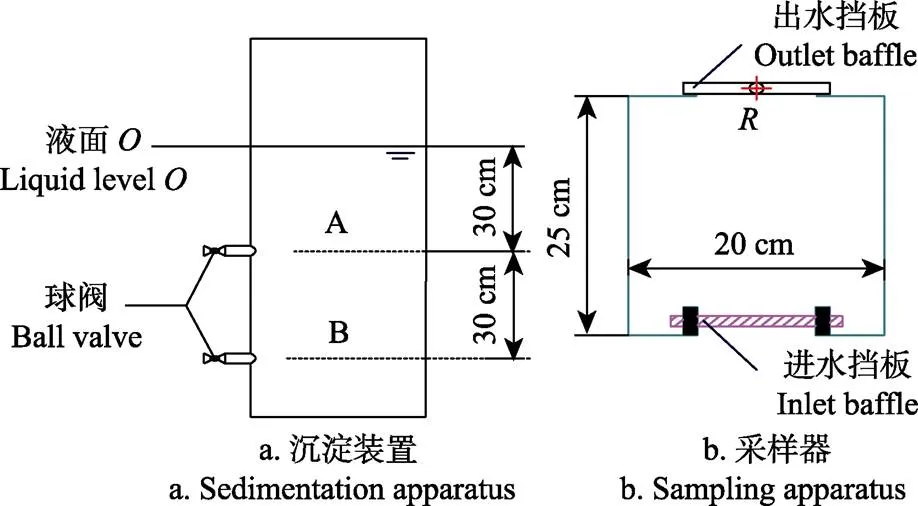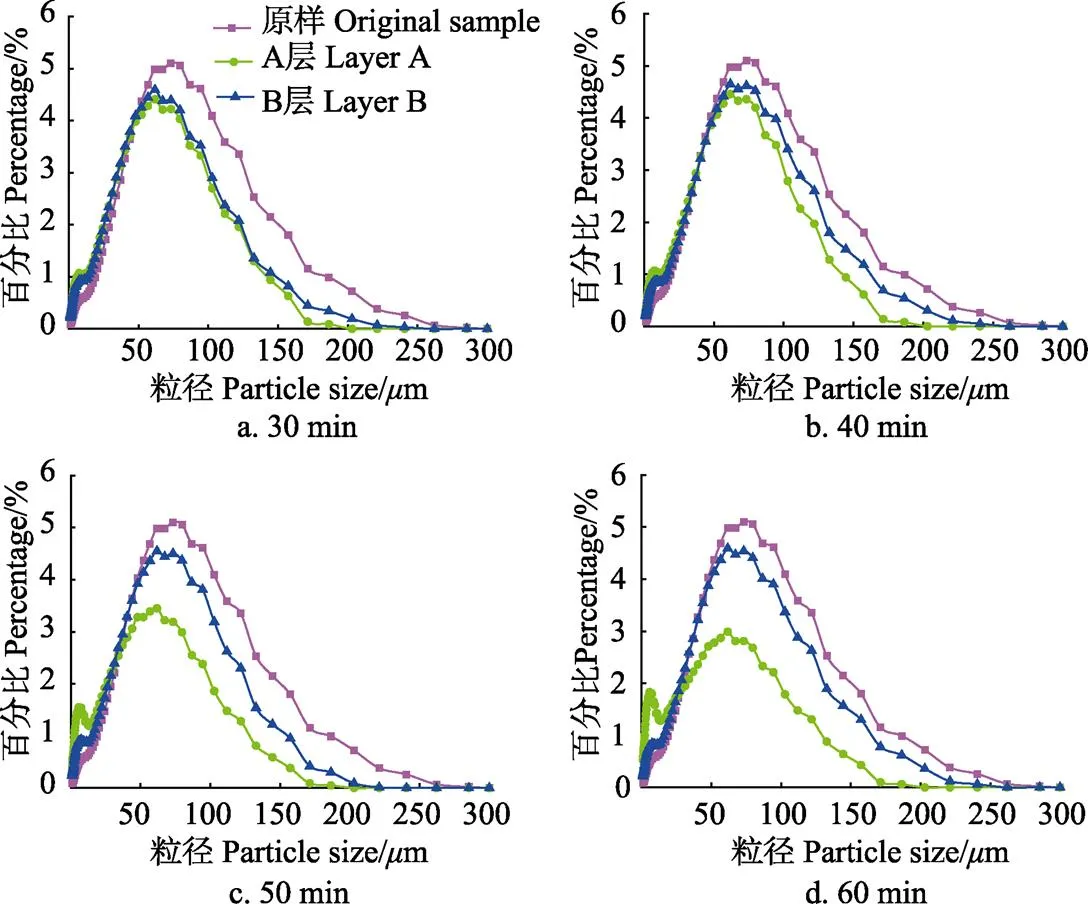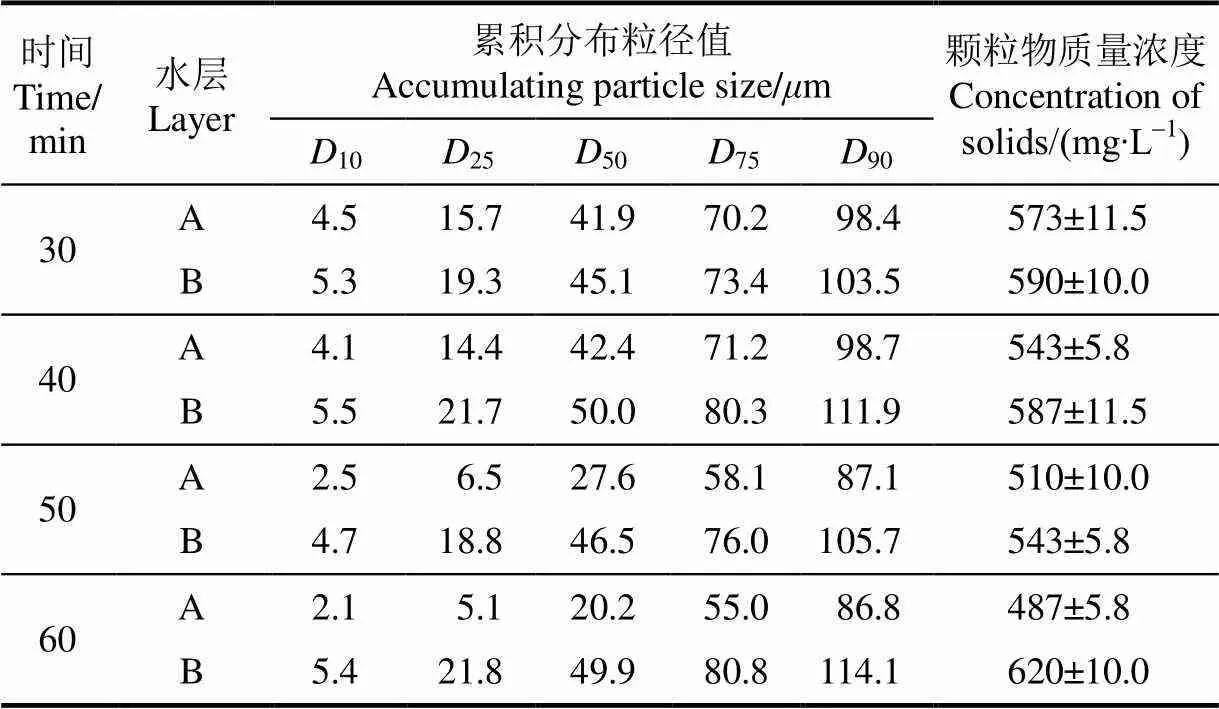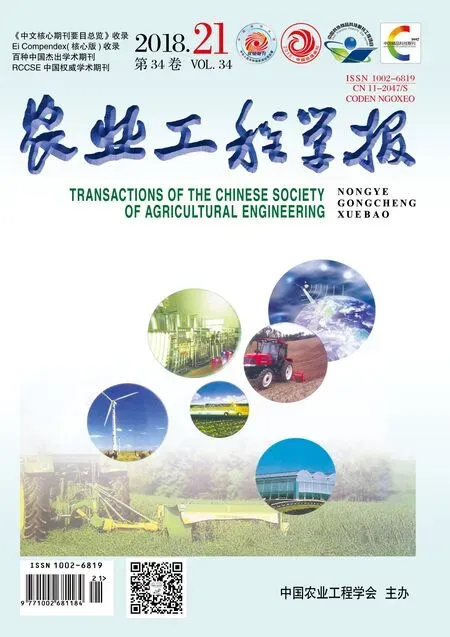乌龟温室养殖水中悬浮颗粒物的沉降特性
季明东,李海军,李建平,叶章颖,朱松明
乌龟温室养殖水中悬浮颗粒物的沉降特性
季明东,李海军,李建平,叶章颖,朱松明※
(浙江大学生物系统工程与食品科学学院,杭州 310058)
养殖水体中固体颗粒物的沉降特性对养殖池和沉淀池的优化设计非常重要。在乌龟温室养殖中期,取距池底 10 cm处的养殖水作为沉淀原样进行静态沉淀试验,测得原样的悬浮颗粒物质量浓度为(763±15.3) mg/L,粒径分布范围是1~300m,其中粒径>100m的颗粒物体积占20.4%,50~100m的占39.1%,<50m的占40.5%。结果表明:在一定的深度范围内颗粒物沉淀速率不受沉淀池深度影响,但若沉淀池太浅且颗粒物浓度较高时会发生拥挤和压缩沉淀;对于乌龟养殖中期的水体,确定了沉淀池的溢流速率和颗粒物去除率之间的关系,当溢流速率为0.0167 cm/s,悬浮颗粒物的去除率为24.9%,且溢流出的水体中总体积90%的颗粒物粒径<98.4m,50%的颗粒物粒径<41.9m;在龟鳖温室养殖池中设置平流式沉淀池可有效地进行悬浮颗粒物的管理和去除,且随着养殖水体中细微颗粒物的增加,溢流速率可随之减小。
颗粒物;沉淀;去除率;粒径分布;乌龟养殖
0 引 言
2016年中国水产品养殖产量5 142万t,水产品人均占有量达到49.9 kg[1],已成为人们日常重要的副食之一。养殖过程中产生的残饵和粪便等废弃颗粒物的高效去除是养殖水处理首要的也是最为关键的环节,对于稳定水质、提高养殖密度和效益具有重要意义[2-4]。养殖水体中的颗粒物粒径分布(particle size distribution,PSD)和沉降特性对其高效管理和去除具有重要作用。
PSD在市政和工业污水等领域有较多的研究[5-6],而在水产养殖中的研究相对较少,且部分研究是通过不同孔径的滤网进行过滤处理得到的,其所得的结果受试验误差的影响较大[3-4, 7-8]。Patterson等[9-10]发现水产养殖中颗粒物粒径的数量分布符合幂定律,通过对数转换和线性回归后可得到一条斜率为的直线,值可表征颗粒物数量分布特性,该值越大表明细微颗粒物数量相对越多,并通过试验得出值的范围是2.9~4.6,然而针对颗粒物粒径体积分布的研究较少。颗粒物沉淀有4种类型:自由、絮凝、拥挤和压缩沉淀。自由沉淀时颗粒物浓度较低,可适用斯托克斯定律;絮凝是部分颗粒物在沉淀过程中凝聚其他颗粒物而加速沉淀;拥挤沉淀时颗粒物浓度较高,沉淀速率较低;压缩沉淀时颗粒物浓度极高,表现为颗粒群体被压缩,一般发生在沉淀池底部,进行非常缓慢。养殖水体中的颗粒物在静止状态下沉淀,能够得到沉淀速率分布曲线,其横坐标为沉淀速率,纵坐标为小于或等于沉淀速率时的颗粒物质量分数[11-12]。另外,溢流速率是指流入沉淀池的水体流量和沉淀池溢流表面积之比,可作为沉淀速率,再根据沉淀速率曲线估算出沉淀池的理论颗粒物去除率[13-15]。颗粒物的沉淀速率可以通过PSD、颗粒物密度和形状等计算得到,沉淀速率和PSD之间的关系可通过斯托克斯定律相互估算得到[16-17]。Magill等[18]通过图像处理获得了粪便颗粒物的粒径及其体积,给出了粪便颗粒物粒径和沉淀速率分布图,该方法存在着测试误差并且只能测得粒径较大的颗粒物。也有研究者通过颗粒物沉淀的方法来获得PSD,然而所需时间较长并且可靠性有待进一步验证[19-21]。
本文针对龟鳖温室大棚养殖中后期水体中悬浮颗粒物浓度高和水质难控,取乌龟温室养殖池中底层的水样进行静态沉淀试验,通过采用米氏散射原理的激光粒度仪测得悬浮颗粒物粒径的体积分布,并测定颗粒物质量浓度,从而得到悬浮颗粒物的沉降特性。
1 龟鳖温室大棚养殖情况
龟鳖养殖业是中国长三角地区村镇经济的重要产业。龟鳖温室大棚养殖,因效益高、成长快和易控制等优势是当前普遍采用的养殖方式。在养殖过程中,由于废弃颗粒物去除率低造成的换水量大和养殖废水排放多等问题,严重制约了产业的可持续发展。温室龟鳖的养殖密度一般为每平方25~30只,养殖池水深为1.0 m,养殖水温为25~28 ℃,养殖过程中产生的粪便残饵等颗粒物受龟鳖频繁活动影响会迅速破碎分解,由此恶化了养殖池生态环境,造成氨氮浓度增加、曝气溶氧困难[22]。目前在养殖池中频繁的添加硝化细菌以及时去除氨氮和亚硝酸盐,造成养殖成本增加,并且仍需定期换水,由此也引起了养殖能耗增加。温室龟鳖养殖池颗粒物排出原理如图1所示,养殖池底部为斜坡结构,高于位置,养殖产生的颗粒物会在处的集污槽内聚集,通过定期打开管道阀门以排出废弃颗粒物。该方法在颗粒物从向聚集时由于龟鳖行为活动和曝气等原因,使得大粒径颗粒物极易破碎成悬浮颗粒物,只有部分大粒径颗粒物能够在集污槽内聚集;在养殖中后期,养殖池中悬浮颗粒物浓度极高,造成颗粒物排出困难,换水量大且养殖废水排放多。另外,研究认为养殖水体中的细微悬浮颗粒物也是制约养殖密度增加的主要因素[23-24]。

图1 温室龟鳖养殖池颗粒物排出原理
龟鳖温室大棚养殖产生的颗粒物及时高效去除对提高养殖密度和节约养殖成本具有重要作用,尤其是在龟鳖频繁活动下产生的悬浮颗粒物。在当前大粒径颗粒物通过集污槽去除的基础上,添加平流式沉淀池来去除悬浮颗粒物以期综合管理养殖过程中产生的固体颗粒物,降低养殖中后期的悬浮颗粒物浓度,从而改善水质和提高养殖效益。另外,受龟鳖活动产生的悬浮颗粒物的沉降特性对沉淀池设计有重要的参考价值。
2 材料与方法
2.1 静态沉淀试验装置
沉淀装置和采样器如图2所示。静态沉淀试验装置为圆柱形,总高为100 cm,直径为20 cm,通过采样器取乌龟温室养殖中期时距养殖池底部10 cm处的养殖水体(沉淀原样)放入该沉淀装置内使得水深为80 cm,取样点设A和B两点(A点靠近沉淀装置的中心,B点靠近沉淀装置的底部,取样点A和B可表征出悬浮颗粒物在沉淀过程中不同深度上的差异),通过打开球阀可取得A和B层的水样,OA和AB的距离为30 cm。

图2 沉淀装置和采样器
沉淀开始前,轻轻搅动水体使得颗粒物在整个沉淀装置内均匀分布。采样器的原理是当其放入养殖池水体中时,底部的进水挡板(向上滑动)打开进水,在下沉过程中顶部的出水挡板(绕中心旋转)打开此时底部进水、顶部出水,当采样器停在养殖池的某深度时可取得对应深度的水体。设A层以上30 cm高度内的沉降区域为ZA,B层以上30 cm高度内的沉降区域为ZB。
2.2 取样和测试方法
设置静态沉淀时间:5、10、15、20、30、40、50和60 min共8组。取养殖池底层的水体放入沉淀试验装置,经时沉淀后取A和B层水样(采样器所取的沉淀原样应尽量均匀一致;每个沉淀时间重复3次)。水样通过Bettersize3000plus激光粒度仪(丹东百特仪器有限公司)测定其颗粒物粒径的体积分布。固体悬浮颗粒物质量浓度的测定按照国家标准方法(GB17378.4-1998)进行,所用的烘干设备是DGX-9073B-1(上海福玛仪器设备有限公司);循环水式真空泵是SHB-IIIA(上海豫康科教仪器设备有限公司);质量仪器是Sartorius BAS1245(北京赛多利斯科学仪器有限公司),精度为0.0001 g;微孔滤膜(上海兴亚净化材料厂)的孔径为0.45m。
2.3 分析方法
颗粒物粒径体积分布的表示方法有累积体积分布和区间体积分布,2种之间可以计算转化得到。区间体积分布是指各粒径区间的颗粒物体积占总体积的百分比,粒径区间是在激光粒度仪中将1~300m划分为68个区间,并且各个区间呈对数增长。颗粒物累积体积达到10%、25%、50%、75%和90%时的颗粒粒径值(10、25、50、75和90,在激光粒度仪的操作软件中已取均值,因此以下累积分布粒径值直接以均值表示)也可表征样品的粒径分布特征(累积体积分布),通过独立样本检验分析A和B层颗粒物累积分布粒径值以及质量浓度之间的差异,显著性水平为0.05。
根据颗粒物粒径分布和颗粒物质量浓度的变化,分析计算得出乌龟温室养殖水中的悬浮颗粒物在不同沉淀速率下的颗粒物去除率,单位为%,如公式(1)所示。

式中C为沉淀原样的颗粒物质量浓度,C为静态沉淀时A层的颗粒物质量浓度,单位为mg/L。
3 结果与分析
3.1 沉淀原样的颗粒分布
乌龟温室养殖过程中产生的大粒径颗粒物在养殖池内沉淀,并通过养殖池底部的斜坡进入集污槽内,然而部分颗粒物未及时到达集污槽内便受乌龟活动影响破碎成粒径较小的悬浮颗粒物。在养殖中期取养殖池底部沉淀的颗粒物进行粒径测试发现绝大多数颗粒物粒径在0.2~1.02 mm之间,而养殖池上层水体中的颗粒物粒径分布在0.5~200m之间。
通过采样器取得的沉淀原样,其悬浮颗粒物质量浓度为(763±15.3) mg/L,粒径分布范围是1~300m,其中粒径>100m的颗粒物体积占颗粒物总体积的20.4%,粒径50~100m的占39.1%,粒径<50m的占40.5%;另外,沉淀原样的颗粒物累积体积分布10、25、50、75和90粒径值分别是12.4、33.7、59.7、91.7和127.4m。受乌龟活动影响产生的悬浮颗粒物如果不能及时去除,会进一步分解成细微颗粒物(养殖中期时养殖池底层的沉淀原样中粒径<50m颗粒物体积已占40.5%),从而造成细微颗粒物浓度高、水质恶化,使得养殖密度难以提高和养殖成本增加。养殖池底层的悬浮颗粒物可通过平流式沉淀池进行去除以稳定水质。
3.2 沉淀时间5~20 min的颗粒分布
沉淀时间5~20 min下A、B层和沉淀原样的颗粒物粒径区间分布之间的比较如图3所示。表1为沉淀时间5~20 min下A和B层的颗粒物累积分布10、25、50、75和90的粒径值。

图3 沉淀时间5~20 min下A、B层和沉淀原样的颗粒粒径区间分布
在静态沉淀时间为5 min时,A和B层的颗粒物粒径区间分布规律相似,且与沉淀原样的颗粒物粒径区间分布相差较小,另外A和B层累积分布90的粒径值有显著性差异,其余累积分布的粒径值均无显著性差异;在沉淀时间10 min时,A和B层的颗粒物粒径区间分布相差较小,此时累积分布75和90的粒径值有显著性差异(<0.05),其余累积分布粒径值无显著性差异;在沉淀时间15 min时,A和B层的颗粒物粒径区间分布相差也较小,但是A和B层的颗粒物各累积分布粒径值均有显著性差异(<0.05);在沉淀时间20 min时,A和B层的颗粒物粒径区间分布差异较大,但是B层的颗粒物粒径区间分布和累积分布粒径值与沉淀原样相似,此时A和B层的各累积分布粒径值均有显著性差异(<0.05)。此外A和B层的颗粒物浓度在沉淀时间5和10 min时无显著差异,在15和20 min时有显著性差异(<0.05)。

表1 沉淀时间5~20 min下A和B层颗粒物累积分布粒径值
注:*表示该分类下A和B层累积分布粒径值(颗粒物质量浓度)之间差异显著(<0.05)。
Note: The superscript * represents significant differences between layer A and B at the same settling time (<0.05).
在沉淀时间5和10 min时,沉降区域ZA中的颗粒物下降到ZB区域中但未影响ZB区域中绝大多数颗粒物的沉降,表现为A和B层的颗粒物粒径分布和颗粒物浓度相差较小,这也说明了沉淀装置的深度不影响颗粒物的沉淀速率。但在沉淀时间10 min时,区间分布表明A层粒径>100m的颗粒物所占的百分比略小于B层,是由于受沉降区域ZA和ZB中颗粒物浓度差异的影响(此时差异较小),A层粒径>100m的颗粒物沉降相对于B层的较容易;在沉淀时间15 min时,区间分布表明A层粒径>50m的颗粒物所占的百分比略大于B层,累积分布表明A层的颗粒物各累积分布粒径值均大于B层,原因也是受沉降区域ZA和ZB中颗粒物浓度差异的影响(此时差异较大),沉降区域ZA中颗粒物浓度降低使得粒径>50m的颗粒物沉降加快并沉降到A层,而ZB中由于颗粒物浓度增大阻碍了粒径>50m的颗粒物沉降到B层。
随着沉淀的进行,沉降区域ZA中的颗粒物逐渐下降到ZB区域中,ZA和ZB中的颗粒物浓度差异逐渐增大,从而引起沉淀时间5~15 min内A、B层颗粒物粒径分布和颗粒物浓度的波动。在沉淀时间20 min时,区间分布表明A层粒径>50m的颗粒物所占的百分比小于B层,且B层的颗粒物粒径区间分布与沉淀原样相似,另外B层颗粒物浓度突变且大于原样的颗粒物浓度,认为此时由沉降区域ZA中下降的颗粒物已经影响到B层颗粒物的粒径分布即由ZA中沉降的颗粒物已下降到B层。
3.3 沉淀时间30~60 min的颗粒分布
沉淀时间30~60 min下A、B层和沉淀原样的颗粒物粒径区间分布之间的比较如图4所示。表2为沉淀时间30~60 min下A和B层的颗粒物累积分布10、25、50、75和90的粒径值。

图4 沉淀时间30~60 min下A、B层和沉淀原样的颗粒粒径区间分布

表2 沉淀时间30~60 min下A和B层颗粒物累积分布粒径值
注:A和B层累积分布粒径值(颗粒物质量浓度)之间差异均显著(<0.05)。
Note: There were significant differences between layer A and B at the same settling time (<0.05).
在静态沉淀时间30~60 min下,区间分布表明A层粒径>50m的颗粒物所占的百分比小于B层,并且随着沉淀时间的增加,A和B层粒径>50m的颗粒物所占百分比之间的差异越明显;A层粒径<25m的颗粒物所占百分比随着沉淀时间增加而增大,甚至在粒径5~10m的范围内出现了百分比的另一个峰值;累积分布表明A和B层的颗粒物各累积分布粒径值均有显著差异;A层的颗粒物浓度稳定下降中,而B层的颗粒物浓度处于波动中。另外,A层各累积分布粒径值在沉淀时间30和40 min时相差较小,且50和60 min时A层的各累积分布粒径值也相差较小;在30~60 min下B层的各累积分布粒径值在波动中。
在沉淀时间30~60 min下,认为由沉降区域ZA中粒径>50m的颗粒物下降到ZB中,因此A层的颗粒物浓度稳定下降,且粒径>50m的颗粒物所占百分比也逐渐减小,而沉降区域ZB中颗粒物浓度的变化引起了B层颗粒物粒径分布和浓度的波动。由于粒径<25m的颗粒物在颗粒物浓度较高时难以通过自身重力进行沉降,因此随着粒径>50m的颗粒物所占百分比的降低,粒径 <25m的颗粒物所占百分比逐渐增大,并且在5~10m的粒径范围内出现了峰值。
3.4 颗粒物沉淀速率与去除率
在20 min时由沉降区域ZA中下降的颗粒物已经影响到B层的颗粒物粒径分布,同时也表明了沉降区域ZA中各深度上均有颗粒物通过A层到达沉降区域ZB中,也说明了ZA中各位置上的颗粒物浓度均已降低,且在20~ 60 min内A层的颗粒物浓度一直在减小。在沉淀时间20~60 min内,可认为颗粒物在沉降区域ZA内的平均沉降速率为/(即沉淀装置中OA的距离和沉淀时间之比),而时A层颗粒物浓度和沉淀原样颗粒物浓度的差值即为该沉淀速率下的颗粒物去除量,并可计算得到去除率(可认为A层为平流式沉淀池的溢流液面,沉淀速率/为沉淀池的溢流速率)。
对于乌龟温室养殖中期的沉淀原样,颗粒物的沉淀速率与去除率对应关系如表3所示。平流式沉淀池的溢流速率可选为0.0167 cm/s,此时悬浮颗粒物的理论去除率为24.9%,且溢流出的水体中总体积90%的颗粒物粒径<98.4m,50%的颗粒物粒径<41.9m。在相同去除率下若采用微滤机去除该水体中的悬浮颗粒物,根据沉淀原样的粒径体积分布,微滤机滤网的孔径需小于90m,且无法避免由滤网过滤和反冲洗引起的颗粒物破碎,并对粒径小于滤网孔径的细微颗粒物几乎无去除作用。

表3 颗粒物沉淀速率与去除率
在龟鳖温室养殖池中,利用微水体流动设置平流式沉淀池,在养殖前期由于水体中细微颗粒物较少,沉淀池可选用较大的溢流速率;在养殖中后期随着养殖水体中细微颗粒物增加,沉淀池的溢流速率可随之减小。
4 结 论
对受乌龟行为活动影响下产生的悬浮颗粒物进行静态沉淀试验,沉淀原样中的悬浮颗粒物质量浓度为(763±15.3) mg/L,粒径分布范围是1~300m,其中粒径>100m的颗粒物体积占20.4%,粒径50~100m的占39.1%,粒径<50m的占40.5%。沉淀试验表明:
1)在沉淀时间10 min内,A和B层颗粒分布相似,说明沉淀池的深度不影响颗粒物沉淀速率;但在沉淀时间10~60 min内,从 A和B层的颗粒分布变化中说明了沉淀池必须要有一定的深度,尤其是对于颗粒物浓度较高的情况下,颗粒物的沉降为拥挤沉淀,且颗粒物浓度越高沉淀速率会降低,若沉淀池深度不够甚至会发生压缩沉淀,这会大大降低颗粒物的沉淀去除率。
2)对于乌龟养殖中期的水体,在颗粒物粒径体积分布变化的基础上,确定了沉淀池的溢流速率和颗粒物去除率之间的关系,当溢流速率为0.0167 cm/s时,悬浮颗粒物的去除率为24.9%,且溢流出的水体中总体积90%的颗粒物粒径<98.4m,50%的颗粒物粒径<41.9m。
3)利用微水体流动设置平流式沉淀池可有效地进行悬浮颗粒物的管理和去除,避免颗粒物破碎而进一步恶化水质,且随着养殖水体中细微颗粒物的增加,沉淀池的溢流速率可随之减小。
沉淀可作为龟鳖温室养殖水质管理的重要环节,是悬浮颗粒物去除行之有效的方法,对稳定水质、减小换水量和提高养殖效益具有重要作用。
[1] 农业部渔业渔政管理局. 中国渔业统计年鉴[M]. 北京:中国农业出版社,2017:21.
[2] 刘晃,陈军,倪琦,等. 基于物质平衡的循环水养殖系统设计[J]. 农业工程学报,2009,25(2):161-166. Liu Huang, Chen Jun, Ni Qi, et al. Design of a recirculating aquaculture system based on mass balance [J]. Transactions of the Chinese Society of Agricultural Engineering (Transactions of the CSAE), 2009, 25(2): 161-166. (in Chinese with English abstract)
[3] 张成林,杨菁,张宇雷,等. 去除养殖水体悬浮颗粒的多向流重力沉淀装置设计及性能[J]. 农业工程学报,2015,31(增刊1):53-60. Zhang Chenglin, Yang Jing, Zhang Yulei, et al. Design and performance of multiway gravity device on removing suspended solids in aquaculture water[J]. Transactions of the Chinese Society of Agricultural Engineering (Transactions of the CSAE), 2015, 31(Supp.1): 53-60. (in Chinese with English abstract)
[4] Patterson R N, Watts K. Micro-particles in recirculating aquaculture systems: Microscope examination of particles[J]. Aquacultural Engineering, 2003, 28(3/4): 115-130.
[5] Wu J, He C. Experimental and modeling investigation of sewage solids sedimentation based on particle size distribution and fractal dimension[J]. International Journal of Environmental Science & Technology, 2010, 7(1): 37-46.
[6] Sui J, He Y, Karney B W. Flow and high sediment yield from the Huangfuchuan watershed[J]. International Journal of Environmental Science & Technology, 2008, 5(2): 149-160.
[7] 刘长发,徐岩,晏再生,等. 牙鲆养殖循环系统中固体废物的粒径分布与沉降特征[J]. 渔业现代化,2009,36(6): 1-5. Liu Changfa, Xu Yan, Yan Zaisheng, et al. Particle size distribution and settling characteristics of solids waste settled in the recirculating aquaculture system for Japanese flounder culture[J]. Fishery Modernization, 2009, 36(6): 1-5. (in Chinese with English abstract)
[8] Cripps S J. Serial particle fractionation and characterization of an aquacultural effluent[J]. Aquaculture, 1995, 133: 323-339.
[9] Patterson R N, Watts K C, Timmons M B. The power law in particle size analysis for aquacultural facilities[J]. Aquacultural Engineering, 1999, 19(4): 259-273.
[10] Patterson R N, Watts K. Micro-particles in recirculating aquaculture systems: Particle size analysis of culture water from a commercial Atlantic salmon site[J]. Aquacultural Engineering, 2003, 28(3/4): 99-113.
[11] Andoh R Y G, Smission R P M. The practical use of wastewater characterisation in design[J]. Water Science and Technology, 1996, 33(9): 127-134.
[12] Wong K, Piedrahita R H. Settling velocity characterization of aquacultural solids[J]. Aquacultural Engineering, 2000, 21(4): 233-246.
[13] Brinker A, Koppe W, Rosch R. Optimized effluent treatment by stabilized trout faeces[J]. Aquaculture, 2005, 249(1/2/3/4): 125-144.
[14] Brinker A, Rosch R. Factors determining the size of suspended solids in a flow-through fish farm[J]. Aquacultural Engineering, 2005, 33(1): 1-19.
[15] Merino G E, Piedrahita R H, Conklin D E. Settling characteristics of solids settled in a recirculating system for California halibut () culture[J]. Aquacultural Engineering, 2007, 37(2): 79-88.
[16] Chen Y S, Beveridge M C M, Telfer T C, et al. Physical characteristics of commercial pelleted Atlantic salmon feeds and consideration of implications for modelling of waste dispersion through sedimentation[J]. Aquaculture International, 1999, 7(2): 89-100.
[17] Chen Y S, Beveridge M C M, Telfer T C, et al. Settling rate characteristics and nutrient content of the faeces of Atlantic Salmon,, and the implications for modelling of waste dispersion[J]. Aquaculture Research, 1999, 30(5): 395-398.
[18] Magill S H, Thetmeyer H, Cromey C. Settling velocity of faecal pellets of gilthead sea bream (.) and sea bass () and sensitivity analysis using measured data in a deposition model[J]. Aquaculture, 2006, 251(2): 295-305.
[19] Yoshida H, Masuda H, Fukui K, et al. Particle size measurement with an improved sedimentation balance method and microscopic method together with computer simulation of necessary sample size[J]. Advanced Powder Technology, 2001, 12(1): 79-94.
[20] Yoshida H, Masuda H, Fukui K, et al. Particle size measurement of standard reference particle candidates with improved size measurement devices[J]. Advanced Powder Technology, 2003, 14(1): 17-31.
[21] Sugasawa H, Yoshida H. Estimation of particle size distribution using the sedimentation method enhanced by electrical-potential[J]. Separation and Purification Technology, 2017, 187: 193-198.
[22] 陈重军. 龟鳖养殖废水厌氧氨氧化处理及其微生物机理研究[D]. 杭州:浙江大学,2013. Chen Chongjun. Study on Anammox Treatment of Turtle Aquaculture Wastewater and its Microbial Mechanism[D]. Hangzhou: Zhejiang University, 2013.
[23] Badiola M, Mendiola D, Bostock J. Recirculating aquaculture systems (RAS) analysis: Main issues on management and future challenges[J]. Aquacultural Engineering, 2010, 51(6): 26-35.
[24] Martins C I M, Eding E H, Verdegem M C J, et al. New developments in recirculating aquaculture systems in Europe: A perspective on environmental sustainability[J]. Aquacultural Engineering, 2010, 43(3): 83-93.
Settling characteristics of suspended solids in greenhouse turtle aquaculture water
Ji Mingdong, Li Haijun, Li Jianping, Ye Zhangying, Zhu Songming※
(310058,)
The settling characteristics and size distribution of solid wastes in aquaculture water play a critical role in designing rearing tank and sedimentation basin. The greenhouse turtle culture is a widely used farming mode, due to its high efficiency and easy to control. The main solid wastes are uneaten feed, faeces and bacterial flocs. Solid wastes can lead to poor water quality and aquacultural benefit if without effectively removed. Research showed that the heterotrophic bacteria can use particulate organic matter for mineralization process. This process not only consumes oxygen, but also produces ammonia. The metabolism of reared organisms also produces ammonia, which lead to a rapid deterioration of water quality. Solids management and removal is the basis for maintaining the aquaculture system operating stably, it is also of great significance for increasing density and ensuring the safety of reared organisms, especially the suspended particles with long contact time and large contact area. Turtle culture is an important economic industry in Yangtze river delta region. In the rearing process, the low removal efficiency of solids, a lot of water exchange and sewage discharge restrict the development of this economic industry. In the middle and later stage of turtle culture, the accumulation of suspended particles caused the water quality to deteriorate and a frequent water exchange, resulting in the increase of rearing cost. The particles under the influence of turtle frequent activities, those large particles are easily broken into suspended particles which is very terrible for the turtle culture. This research took the turtle culture water near the bottom of rearing tank for a simple static sedimentation experiment. The water depth of settling device was 80 cm, the length of two sampling points was 30 cm and the shallow one away from liquid level was also 30 cm. The two sampling points can characterize the difference of suspended particles at different depths in the settling process. The 8 groups of static settling time were 5, 10, 15, 20, 30, 40, 50 and 60 min, respectively. Each group of settling time for static settling experiment was repeated for 3 times. The particle size-volume distribution of water samples was measured by a non-invasive laser scatter instrument. The presentation method of particle size-volume distribution includes interval volume distribution and cumulative volume distribution which can reflect the characteristics of particles size-volume distribution in different aspects and can also be converted to each other. The mass concentration of suspended particles in the original sample was (763±15.3) mg/L and the particles size ranged from 1 to 300m. The particles size >100m in total volume accounted for 20.4%, the particles size 50-100m in total volume accounted for 39.1%, and particles size <50m in total volume accounted for 40.5%. The results of static sedimentation experiment showed that the depth of the sedimentation will not affect the settling velocity, but it must ensure a certain depth to avoid higher concentration of particles accumulating in the settling zone which will occur hindered and compression settling. For the water in the middle stage of turtle culture, when the overflow rate was 0.0167 cm/s in the sedimentation basin, the removal efficiency of suspended particles was 24.9%. 90% in total volume of the particles in the outflow water was less than 98.4m, and 50% in total volume was less than 41.9m. For greenhouse turtle culture, the flat flow sedimentation basin can effectively remove suspended particles, and with the increase of fine particles in the aquaculture water, the overflow rate of sedimentation basin can be reduced accordingly.
particles; sedimentation; removal efficiency; particle size distribution; turtle culture
10.11975/j.issn.1002-6819.2018.21.027
S238
A
1002-6819(2018)-21-0222-06
2018-06-19
2018-08-14
国家水体污染控制与治理科技重大专项课题“温室甲鱼清洁生产与废水生态净化处理成套技术研究及示范”(编号:2014ZX07101-012);杭州市科技计划项目“基于环境友好型池塘内循环流水养殖技术的示范与推广”(编号20172015A05)。
季明东,博士生,主要从事设施水产备装备研究。 Email:mingdongji_zju@163.com
朱松明,教授,博士生导师,主要从事农业生物环境工程与食品非热加工新技术研究。Email:zhusm@zju.edu.cn
季明东,李海军,李建平,叶章颖,朱松明. 乌龟温室养殖水中悬浮颗粒物的沉降特性[J]. 农业工程学报,2018,34(21):222-227. doi:10.11975/j.issn.1002-6819.2018.21.027 http://www.tcsae.org
Ji Mingdong, Li Haijun, Li Jianping, Ye Zhangying, Zhu Songming.Settling characteristics of suspended solids in greenhouse turtle aquaculture water[J]. Transactions of the Chinese Society of Agricultural Engineering (Transactions of the CSAE), 2018, 34(21): 222-227. (in Chinese with English abstract) doi:10.11975/j.issn.1002-6819.2018.21.027 http://www.tcsae.org

